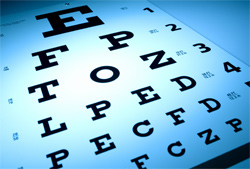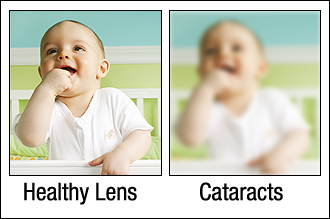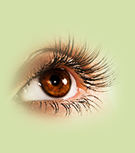Our Services
Comprehesive Eye Care for the Entire Family
 Our doctors are excellent with children and recommend a comprehensive eye exam between the ages of 4 and 6 at least every two years. Children are oftem more responsive to treatment when problems are diagnosed early in their lifetime. Children who need eye glasses or contact lenses are recommended to see an optometrist every year. It is highly recommended for anyone starting at age 4 to 6 to see an optometrist or ophthalmologist at least every two years. Patients wearing glasses and/or contact lenses shoud see a doctor every year. Patients being treated for certain eye disorders such as glaucoma, macular degeneration or cataracts are recommended to see the doctor at lease every 6 months to 1 year.
Our doctors are excellent with children and recommend a comprehensive eye exam between the ages of 4 and 6 at least every two years. Children are oftem more responsive to treatment when problems are diagnosed early in their lifetime. Children who need eye glasses or contact lenses are recommended to see an optometrist every year. It is highly recommended for anyone starting at age 4 to 6 to see an optometrist or ophthalmologist at least every two years. Patients wearing glasses and/or contact lenses shoud see a doctor every year. Patients being treated for certain eye disorders such as glaucoma, macular degeneration or cataracts are recommended to see the doctor at lease every 6 months to 1 year.
No-Stitch Cataract Surgery
What are cataracts?
 A cataract is an opacification (clouding) of the natural lens inside of the eye. The lens helps us focus on objects at different distances. As a part of the normal aging process, changes in the lens can cause it to become cloudy. Left untreated, a cataract can become so dense that it causes blindness. In fact, cataracts are the leading cause of blindness in the world. The original meaning of "cataract" is "waterfall," and the name was chosen because distorted vision caused by a cataract reminded people of the distorted view that is obtained when looking through a waterfall.
A cataract is an opacification (clouding) of the natural lens inside of the eye. The lens helps us focus on objects at different distances. As a part of the normal aging process, changes in the lens can cause it to become cloudy. Left untreated, a cataract can become so dense that it causes blindness. In fact, cataracts are the leading cause of blindness in the world. The original meaning of "cataract" is "waterfall," and the name was chosen because distorted vision caused by a cataract reminded people of the distorted view that is obtained when looking through a waterfall.
Who gets cataracts?
Most people who develop cataracts are older than 60 years. Cataracts in older people are so common they can be regarded as normal part of the aging process. Among the major conditions related to cataracts are diabetes or injury to the eye. Medications such as steroids can also cause cataract formation.
In rare cases, congenital cataracts are present at birth. These cataracts are usually related to the mother having German measles, chickenpox, or other infectious diseases during pregnancy or to the child having certain syndromes (e.g. Marfan's). Some cataracts are inherited.
What are the symptoms of a cataract?
Typical symptoms include:
- Cloudy, fuzzy, foggy, or filmy vision.
- Changes in the perception of colors.
- Problems driving at night because headlights seem too bright.
- Problems with glare from lamps or the sun.
- Frequent changes in your eyeglass prescription.
- Double vision.
These symptoms can also be signs of other eye problems. If you have any of them, consult an ophthalmologist for an eye examination.
How can cataracts be treated?
The natural lens of the eye that has been damaged by a cataract is surgically removed and then replaced with a clear artificial lens. During the surgery, usually done on an outpatient basis, a tiny incision is made in the eye and the cataract-damaged natural lens is removed through the incision. An artificial lens is then inserted through the same incision. Most patients have significantly improved vision after the procedure.
The treatment for this condition is a procedure called a YAG laser capsulotomy, which is named for the material used to generate the laser energy (yttrium-aluminum-garnet). The doctor uses a laser (light) beam to make a small opening in the capsule through which light can pass unimpeded. This surgery is painless and does not require a hospital stay. Most people see well after a YAG capsulotomy. Your doctor will discuss the risks with you.

What are the benefits of cataract surgery?
Cataract surgery restores quality vision for millions of patients each year. Good vision is vital to an enjoyable lifestyle. Numerous research studies show that cataract surgery restores quality-of-life functions including reading, working, moving around, hobbies, safety, self-confidence, independence, daytime and nighttime driving, community and social activities, mental health, and overall life satisfaction.
What are the risks of cataract surgery?
Cataract surgery is performed millions of times every year in the United States. In fact, it is the most commonly performed surgery in the U.S. About 98 percent of patients have a complication-free experience that results in improved vision. Nevertheless, cataract surgery has risks and complications. Most complications resolve in a matter of days to months. In rare cases, patients lose some degree of vision permanently as a result of the surgery.
Is it still necessary to wear thick glasses after cataract surgery?
No. Today, cataract patients who have artificial or intraocular lenses (IOLs) implanted during surgery may only need reading glasses for close vision. Patients who do not receive IOLs wear contact lenses for distance vision and reading glasses for close vision. Some patients choose to wear multifocal contact lenses for all distances.
Glaucoma
 Glaucoma is a group of diseases that can damage the eye's optic nerve and result in vision loss and blindness. The optic nerve is a bundle of more than 1 million nerve fibers. It connects the retina to the brain. The retina is the light-sensitive tissue at the back of the eye. A healthy optic nerve is necessary for good vision.
Glaucoma is a group of diseases that can damage the eye's optic nerve and result in vision loss and blindness. The optic nerve is a bundle of more than 1 million nerve fibers. It connects the retina to the brain. The retina is the light-sensitive tissue at the back of the eye. A healthy optic nerve is necessary for good vision.
In the front of the eye is a space called the anterior chamber. A clear fluid flows continuously in and out of the chamber and nourishes nearby tissues. The fluid leaves the chamber at the open angle where the cornea and iris meet. When the fluid reaches the angle, it flows through a spongy meshwork, like a drain, and leaves the eye.
Sometimes, when the fluid reaches the angle, it passes too slowly through the meshwork drain. As the fluid builds up, the pressure inside the eye rises to a level that may damage the optic nerve. When the optic nerve is damaged from increased pressure, open-angle glaucoma--and vision loss--may result. That's why controlling pressure inside the eye is important.
Increased eye pressure means you are at risk for glaucoma, but does not mean you have the disease. A person has glaucoma only if the optic nerve is damaged. If you have increased eye pressure but no damage to the optic nerve, you do not have glaucoma. However, you are at risk. Are you seeking a Cleveland Glaucoma eye doctor for a second opinion? If so please read more about this silent theif if sight.
Who is at Risk?
Anyone can develop glaucoma. Some people are at higher risk than others. They include:
- People who are diabetic
- African Americans over age 40.
- Everyone over age 60, especially Hispanic Americans.
- People with a family history of glaucoma.
Immediate treatment for early stage, open-angle glaucoma can delay progression of the disease. That's why early diagnosis is very important. A comprehensive dilated eye exam by one of Cleveland Eye Clinic's eye care professionals can reveal more risk factors, such as high eye pressure, thinness of the cornea, and abnormal optic nerve anatomy. In some people with certain combinations of these high-risk factors, medicines in the form of eyedrops reduce the risk of developing glaucoma by about half.
Types of Glaucoma
Open-angle glaucoma: This is the most common type of glaucoma. The structures of the eye appear normal, but fluid in the eye does not flow properly through the drain of the eye, called the trabecular meshwork.
Angle-closure glaucoma: This type of glaucoma is less common, but can cause a sudden buildup of pressure in the eye. Drainage may be poor because the angle between the iris and the cornea (where a drainage channel for the eye is located) is too narrow. Or, the pupil opens too wide, narrowing the angle and blocking the flow of the fluid through that channel.
Treatment Options
Eye Drops
Glaucoma is typically treated with eye drops that decrease eye pressure either by slowing the amount of fluid produced within the eye or by improving the flow through the drainage angle. Glaucoma medications may produce side effects, so be sure to talk to your doctor if you experience any unusual symptoms.
SLT – Selective Laser Trabeculoplasty
Selective Laser Trabeculoplasty (SLT) is quickly becoming a widely accepted treatment option in glaucoma treatment. SLT offers a new glimpse of hope for glaucoma patients. By engaging in this new laser technology, the ophthalmologists can now lower pressure that can possibly help a patient avoid a more invasive surgery. The surgery might even reduce the dependence on medications or drops.
Selective Laser Trabeculoplasty (SLT) is an advanced laser system that improves the flow of fluid in the eye, lowering Intraocular pressure (IOP) for patients who have glaucoma. SLT uses short pulses of low energy laser light to target melanin-containing cells in a network of tiny channels, called the trabecular meshwork. The objective of the surgery is to help fluids drain out of the eye, reducing intra-ocular pressure that can cause damage to the optic nerve and loss of vision.
Dry Eye
 Dry eye related discomfort is one of the most common complaints heard by eye doctors. The symptoms of dry eyes vary depending on the individual case, however patients that suffer from dry eyes usually experience a number of the following symptoms:
Dry eye related discomfort is one of the most common complaints heard by eye doctors. The symptoms of dry eyes vary depending on the individual case, however patients that suffer from dry eyes usually experience a number of the following symptoms:
- Dryness
- Redness
- Scratchiness
- Blurred Vision
- Foreign body sensation
- Burning sensation
- Sandy/gritty sensation
Dry eye syndrome, often referred to as keratitis sicca or keratoconjunctivitis sicca, is caused by insufficient and/or poor quality tears. There are three main components to human tears. Most human tears are produced by the lacrimal gland. The oily component of tears is produced by the meibomian glands and the third component, the goblet cells, keeps all of the components mixed up. When one of the parts of this mixture becomes unbalanced, dry eye syndrome can occur. There are numerous reasons as to why these glands may not be doing their part.
Insufficient tear production and/or poor tear quality are the most common causes of dry eye syndrome. Inflammation of the lacrimal gland is the most common cause of insufficient tear volume. Meibomian gland dysfunction, inflammation of the glands at the eyelid margin, contributes to poor tear quality. Medications can also cause ocular dryness. Hormonal changes may contribute to insufficient and/or poor quality tears.
Treatment Options for Dry Eye Syndrome
Artificial Tears
Artificial tears containing active ingredients such as carboxymethylcellulose, hydroxypropyl methylcellulose, glycerin, castor oil, polyethyline glycol or polyvinyl alcohol are used in mild cases of dry eyes. Not all artificial tear brands work the same or work in all patients. More severe cases require additional treatment. If you find yourself using your artificial tears three or more times a day you should use a preservative free tear. Most patients find that artificial tears do help, however the affect is only temporary, lasting only 10-15 minutes. Most of these patients will experience significant relief with punctal occlusion.
Punctal Occlusion
The puncta is the small opening found on the edge of the upper and lower eyelids next to the nose. Tears drain out of the eye through the puncta into the nose, this is why your nose runs when you cry. If you aren't producing enough tears then you don't want the tears that you are producing to be drained away. Punctal occlusion is painless and performed in the office, taking only a couple of minutes.
Diabetic Eye Care
 If you have diabetes, you should have your eyes examined at least once a year at the Cleveland Eye Clinic. It is possible that you could develop a disease is called Diabetic Retinopathy. This disease is a leading cause of blindness in American adults. It is caused by changes in the blood vessels of the retina. In some people with diabetic retinopathy, retinal blood vessels may swell and leak fluid. In other people, abnormal new blood vessels grow on the surface of the retina. These changes may result in vision loss or blindness.
If you have diabetes, you should have your eyes examined at least once a year at the Cleveland Eye Clinic. It is possible that you could develop a disease is called Diabetic Retinopathy. This disease is a leading cause of blindness in American adults. It is caused by changes in the blood vessels of the retina. In some people with diabetic retinopathy, retinal blood vessels may swell and leak fluid. In other people, abnormal new blood vessels grow on the surface of the retina. These changes may result in vision loss or blindness.
Often there are no symptoms in the early stages of the disease. Vision may not change until the disease becomes severe. Nor is there any pain. Blurred vision may occur when the macula - the part of the retina that provides sharp, central vision – swells from the leaking fluid. This condition is called macular edema. If new vessels have grown on the surface of the retina, they can bleed into the eye, blocking vision. But, even in more advanced cases, the disease may progress a long way without symptoms. That is why regular eye examinations for people with diabetes are so important.
Early Detection
Finding and treating the disease early, before it causes vision loss or blindness, is the best way to control diabetic eye disease. So, if you have diabetes, make sure you get a dilated eye examination at least once a year. Your eyes will be dilated during the exam. That means eyedrops are used to enlarge your pupils. This allows our eye care professionals to see more of the inside of your eyes to check for signs of the disease.
If you should have diabetic retinopathy laser surgery and appropriate follow-up care can reduce the risk of blindness by 90 percent. However, laser surgery often cannot restore vision that has already been lost. That is why finding diabetic retinopathy early is the best way to prevent vision loss.
SCHEDULE AN APPOINTMENT

Are you ready to schedule an appointment at Clear Choice Eye Center? We specialize in routine and medical eye care and also have a full service optical shop. Click the link below to get started!
VISION CORRECTION

If LASIK laser vision correction is not an option for you, there are other options that may better suit your individual eye conditions and your lifestyle.
PATIENT EDUCATION

Nearsighted individuals typically have problems seeing well at a distance and are forced to wear glasses or contact lenses. The nearsighted eye is usually longer than a normal eye, and its ctornea may also be steeper.
OUR DOCTORS

The ophthalmologists and optometrists at Clear Choice Eye Center are highly trained in the field of eye care and eye surgery. Click here to meet our team of doctors.
CONTACT US

Do you need more information about the Clear Choice Eye Center? We are here to answer any questions you may have. Click here to complete a quick contact form and a member of our staff will contact you.